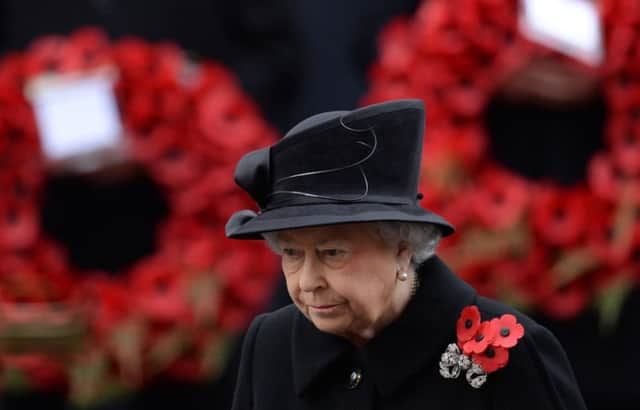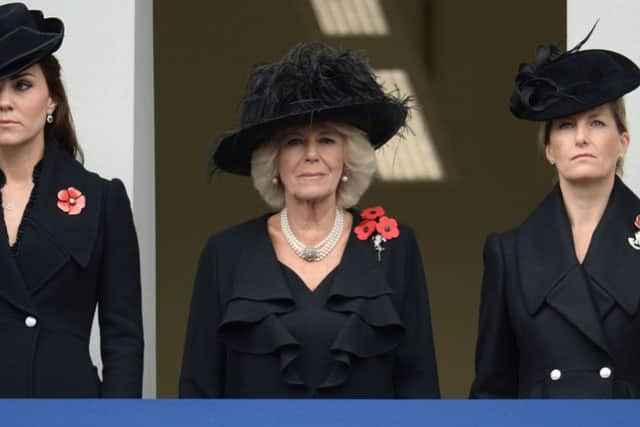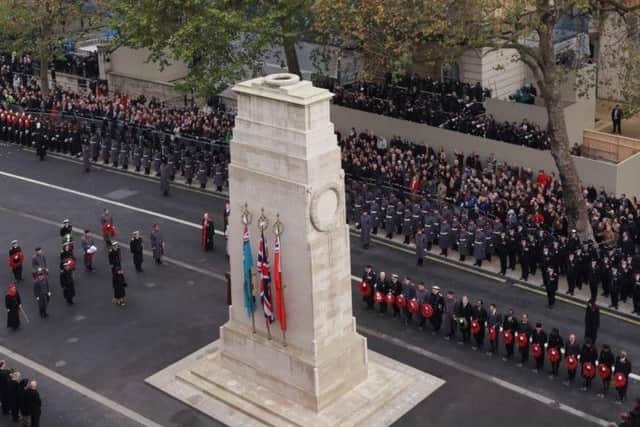Nation falls silent to remember the fallen


The monarch laid the first wreath at the Cenotaph in London’s Whitehall to commemorate those who have made the ultimate sacrifice in the decades since the First World War, bowing her head after paying her respects.
Senior royals, including Second World War veteran the Duke of Edinburgh, the Prince of Wales and the Duke of Cambridge joined politicians, military leaders, veterans and serving personnel in laying wreaths of poppies at the monument.
Advertisement
Hide AdAdvertisement
Hide AdPrime Minister David Cameron described this year’s Remembrance Sunday as “particularly poignant” as 2014 marked the 100th anniversary of the start of the First World War, the 70th anniversary of the D-Day landings and the end of Britain’s 13-year conflict in Afghanistan.


Millions across the UK fell silent in tribute to those lost in war, joining the crowds gathered in central London who stood in a moment of quiet contemplation as Big Ben struck 11am.
Amid heightened fears of a terror attack, there was a large police presence at the Cenotaph in Whitehall, with a helicopter hovering above the site before the ceremony.
Scotland Yard said it had an “appropriate and proportionate” policing plan in place for the event, after four men were arrested in connection with an alleged Islamist terror plot on British soil on Thursday.
Advertisement
Hide AdAdvertisement
Hide AdAt the heart of the service was a two-minute silence, marked at the beginning and end by the firing of a round by the King’s Troop Royal Horse Artillery, using a 13-pounder First World War gun.


At the end of the silence, buglers of the Royal Marines sounded the last post.
In cool and overcast conditions, the royals and dignitaries then laid their wreaths at the Cenotaph.
Mr Cameron was first after the royals to do so, followed by Deputy Prime Minister Nick Clegg and Labour leader Ed Miliband.
Advertisement
Hide AdAdvertisement
Hide AdFormer prime ministers Sir John Major, Tony Blair and London mayor Boris Johnson also took part in the ceremony.
The Duchess of Cambridge and Duchess of Cornwall watched from the Foreign Office balcony.
Mr Cameron said: “Today we stand united to remember the courageous men and women who have served our country, defended our freedoms and kept us safe.
“We remember all those who have fallen and those who have risked their lives to protect us.
Advertisement
Hide AdAdvertisement
Hide Ad“We owe each and every member of our armed forces and the families who support them a tremendous debt - one that can never be repaid - and I pay huge tribute to their bravery and resolve.”
The ceramic poppy field at the Tower of London was an “incredibly moving, yet stark reminder” of how many people gave their lives in the First World War, Mr Cameron added.
It was announced yesterday that the wave section of the artwork - which will have 888,246 ceramic poppies installed by Armistice Day, one for each British and colonial death during the conflict - will remain on show until the end of the month.
The Queen will be joined by the Duke of Edinburgh at the Cenotaph in Whitehall, according to the official website of the British Monarchy.
Advertisement
Hide AdAdvertisement
Hide AdThe Prince of Wales and Duchess of Cornwall will also attend, along with the Earl and Countess of Wessex, the site said.
A two-minute silence at the heart of the service will be marked at the beginning and end by the King’s Troop Royal Horse Artillery firing one round from one of their 13-pounder First World War guns from Horse Guards Parade.
Meanwhile, as dusk falls, images of falling poppies are to be projected on to Parliament’s Elizabeth Tower - popularly known as Big Ben - as part of commemorations of the centenary of the conflict.
A service will also be held at the National Memorial Arboretum in Staffordshire, before wreaths are laid at the stone armed forces memorial.
Advertisement
Hide AdAdvertisement
Hide AdSince last year’s Remembrance Sunday, seven members of the British armed forces have died on operations.
The news comes after Mr Cameron announced a key part of the emotive artwork at the tower of London will remain until the end of the month.
The artwork created by ceramic artist Paul Cummins, with setting by stage designer Tom Piper, features 888,246 ceramic poppies which have progressively filled the Tower’s famous moat.
The piece has proved so popular with visitors that it has been decided that the Wave section of the artwork will remain on show until the end of the month so more people have the opportunity to see it at the Tower.
Advertisement
Hide AdAdvertisement
Hide AdFloodlights have already been installed to allow the poppies to be viewed after dusk after overcrowding in the area forced the closure of nearby Tower Hill Tube station and prompted a plea last weekend urging to visitors to postpone their plans.
Despite a campaign for the poppies to remain long term, Historic Royal Palaces, which runs the Tower of London, has said it intends to start dismantling the artwork on November 12 - the day after Armistice Day - as planned.
A team of 8,000 volunteers has been lined up to start removing and cleaning ceramic poppies, before dispatching them to buyers who have paid £25 each to raise money for armed forces charities.
But after he announced the Wave would remain in place for a few extra weeks, Mr Cameron said the installation, created to mark the centenary of the start of the First World War, had become a “much-loved and respected monument” in a short space of time.
Advertisement
Hide AdAdvertisement
Hide AdThe Wave and the Weeping Window will also go on a tour of sites across the UK until 2018 so as many people as possible can see them. They will eventually go on permanent display at the Imperial War Museum.